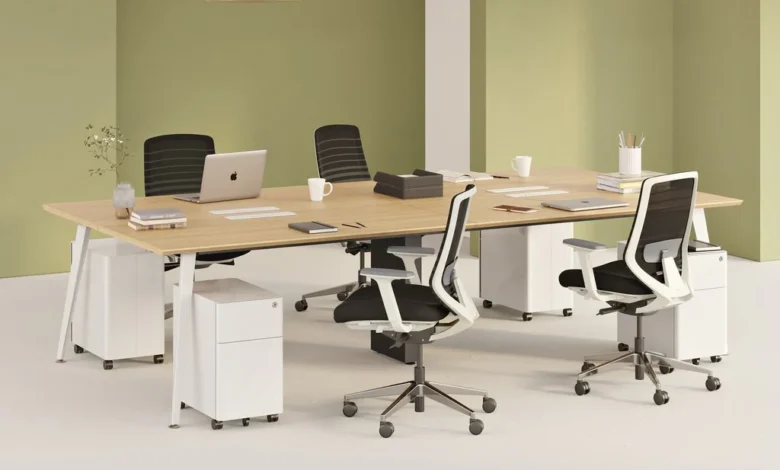Office Desks for Collaboration: Styles That Inspire Teamwork

When designing a modern office, choosing the right office furniture is essential for fostering a collaborative and productive work environment. One of the key elements that can greatly influence teamwork are office desks.
Collaborative desks are not just about functionality but also about creating an atmosphere where employees can easily interact, share ideas, and work together efficiently. The right desk setup can transform a space from a traditional, individual-focused layout to one that promotes communication and idea-sharing.
As companies increasingly embrace flexible and dynamic work environments, it’s important to select office desks that can support both individual tasks and group activities. These desks need to encourage movement, collaboration, and communication. Whether you’re designing a spacious open-plan office or a more intimate shared workspace, the styles of office desks you choose can play a significant role in enhancing the collaborative spirit of your team.
Modular Desks: Flexibility for Group Dynamics
One of the best choices for fostering collaboration is modular office desks. These desks can be rearranged and configured to suit various team sizes and work styles. They are often designed with versatility in mind, making it easy to adjust the layout to accommodate different group tasks or brainstorming sessions.
Modular desks come in many shapes, from rectangular to circular configurations, allowing teams to gather in a way that promotes easy communication and collaboration. The ability to move desks around creates a sense of fluidity within the workspace, which is ideal for businesses that often work on changing projects or require ad-hoc team formations. The flexibility of modular desks helps to prevent the feeling of being stuck at a fixed workstation, allowing employees to switch up their environment based on the project or team they are working with.
This style of desk also helps maintain a more open environment, encouraging conversations between team members that might not happen in traditional, isolated workstations. For companies looking to promote cross-departmental collaboration, modular desks offer an excellent solution. They can easily be expanded to fit larger teams or made more compact for smaller groups, making them a great option for any office size.
Shared Desks: Promoting Close Collaboration
In spaces where communication is key, shared desks are an ideal choice. These desks are designed for two or more people to work side by side, which fosters a sense of camaraderie and teamwork. Unlike traditional desks that focus on individual space, shared desks are built with collaboration in mind.
One of the major advantages of shared desks is that they encourage spontaneous conversations and problem-solving. When team members sit close together, they can easily exchange ideas, discuss challenges, and provide immediate feedback to one another. Shared desks can come in a variety of configurations, from simple two-person desks to larger, more intricate designs for teams of five or six.
Additionally, many shared desks are designed to accommodate different work styles, featuring flexible work surfaces, built-in power outlets, and shared storage options. This flexibility ensures that employees have the tools they need while still being able to collaborate in a seamless and uninterrupted manner. As remote work and hybrid office setups become more common, shared desks are also a great option for employees who come into the office on different days but need to work together when they do.
Standing Desks: Collaborative Mobility
With the increasing awareness of the importance of physical health and well-being, standing desks have become a popular choice for modern offices. These desks allow employees to alternate between sitting and standing throughout the day, which can improve posture, reduce fatigue, and increase focus. For collaborative work, standing desks can be arranged in clusters or groups to encourage interaction while maintaining mobility.
Standing desks are particularly beneficial for team-based tasks that require quick brainstorming sessions or active collaboration. Standing together promotes a more dynamic and engaging conversation, and the ability to move around easily helps avoid the stiffness that can come from sitting for extended periods. Teams can rotate in and out of standing positions to keep the energy levels high while working together.
Furthermore, standing desks are often designed to be highly adjustable, so employees can customise the height and layout to suit their needs. Some standing desks can even be equipped with interactive technology like digital screens or touch interfaces, which can facilitate collaborative meetings and discussions.
Collaborative Workstations: A More Integrated Approach
Collaborative workstations take the concept of shared desks a step further by incorporating an integrated approach to teamwork. These desks are often designed with built-in technology, shared storage, and communal spaces that facilitate easy access to resources. The goal is to create a workstation where multiple people can work together seamlessly, without the barriers of traditional desks.
These collaborative desks are often found in open-plan offices where the emphasis is on team projects, brainstorming, and collective problem-solving. They may feature long, continuous surfaces that allow multiple people to work on the same task at once, or they might have modular sections that can be easily rearranged based on the project at hand. Some collaborative workstations even include built-in privacy panels for times when individuals need to focus while still being part of the larger team environment.
In addition to physical collaboration, these desks often incorporate the latest in digital tools, such as wireless charging stations, touch screens, and shared video conferencing facilities. These technological features enable teams to work together more effectively, regardless of whether they are in the same physical space or connected remotely.
Collaborative Desks with Privacy: Balancing Teamwork and Focus
While collaboration is important, there are times when employees need to focus on individual tasks. In these cases, desks with privacy screens or partitions can offer the best of both worlds. These desks allow for group work and collaboration while still offering some level of personal space.
Many of these desks are designed with acoustic panels or dividers to reduce distractions and allow employees to concentrate when needed. The design enables teams to have more control over their environment, ensuring that they can switch between collaborative work and focused tasks with ease. These desks are ideal for teams that require flexibility – they can sit together when needed, but still have the option to break off into smaller, more focused work sessions when the task requires individual concentration.
The office desk plays a pivotal role in shaping the way teams interact and collaborate. By choosing the right style of desk, whether modular, shared, standing, or collaborative workstations, you can create a workspace that encourages open communication, teamwork, and creativity. Office furniture is not just about aesthetics or functionality; it’s about enhancing the work experience and ensuring that the space meets the dynamic needs of modern teams. By incorporating collaboration-focused designs into your office layout, you’ll inspire your team to work more efficiently and creatively, ultimately driving the success of your business.




